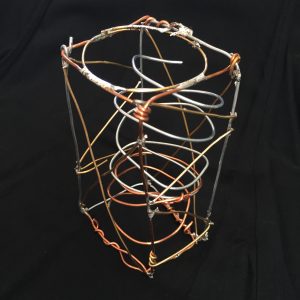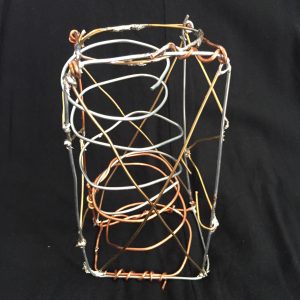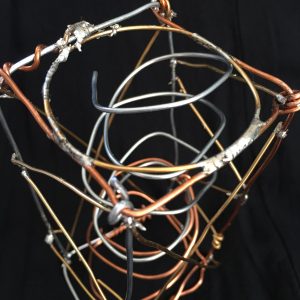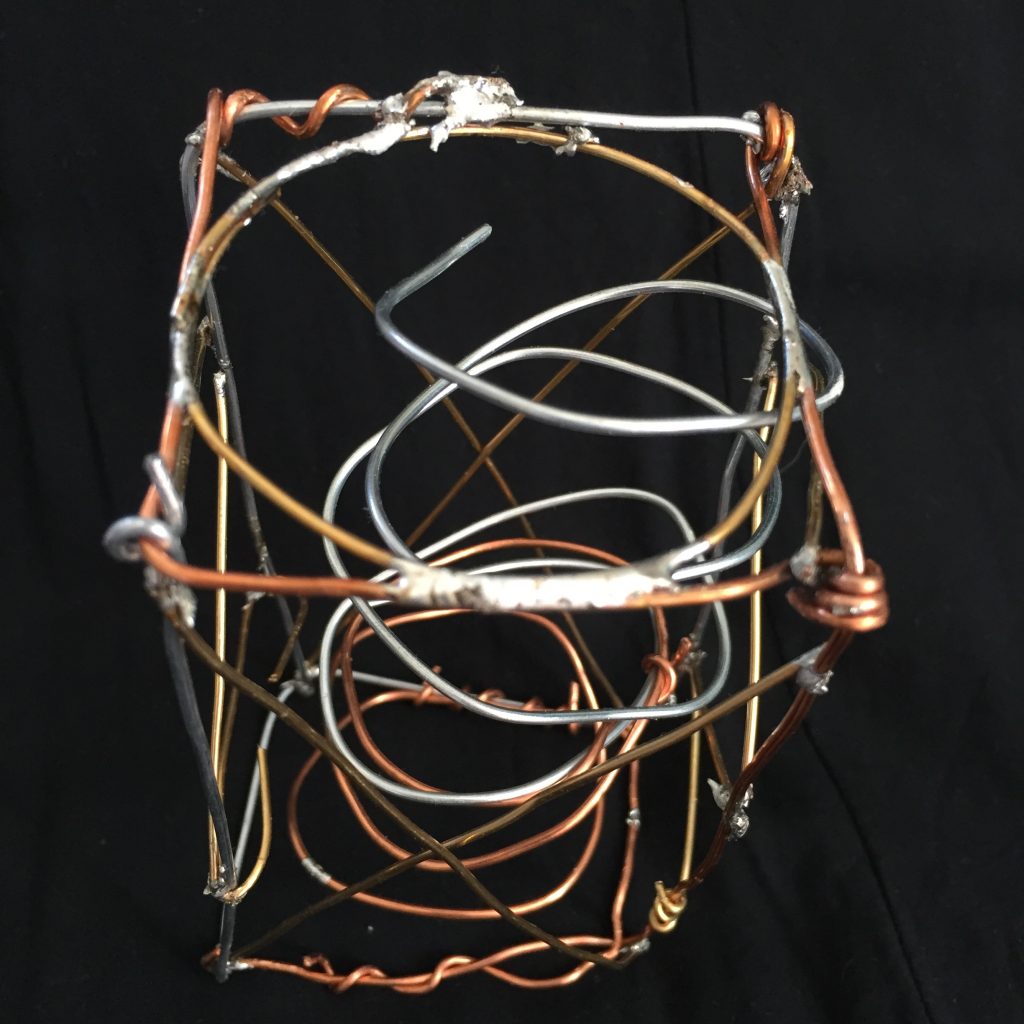 When faced with the task of creating a structure made of wire, our group (Natalie, Kelsey, and Carolyn) chose to put function over fashion. Our primary goal was, “Can we make this stand up and hold a cup,” and everything else was secondary to that. Our group was divided on how to construct the sculpture – two people wanted to go with a spiral-shaped cup holder, while one wanted to create a four-legged rectangular tower. In the end, we compromised and used both ideas in one structure. We exchanged some sketches, but when it came to construction we went with the, “Let’s figure this out as we go” method.
When faced with the task of creating a structure made of wire, our group (Natalie, Kelsey, and Carolyn) chose to put function over fashion. Our primary goal was, “Can we make this stand up and hold a cup,” and everything else was secondary to that. Our group was divided on how to construct the sculpture – two people wanted to go with a spiral-shaped cup holder, while one wanted to create a four-legged rectangular tower. In the end, we compromised and used both ideas in one structure. We exchanged some sketches, but when it came to construction we went with the, “Let’s figure this out as we go” method.
Our process was a collaboration the whole way through – From our initial brainstorm, to the making of the structure, we worked as a group. We met at the Makerspace and dove in. We began by coiling the steel into “legs”, using our hands. We tried to cut the wire as little as possible for the base of the structure because we assumed that the less breakage of the material, the stronger it would be. We used both the soldering and wrapping wire techniques get the structure to stand. This left us with an uneven and assorted look, but a strong base. Once we had a base, we added a ring around the top of the base, to hold diameter of the cup. Soldering a ring together was tricky and took two of us – one holding the ring in place, the other soldering.
 The coil was designed to hold most of the weight of the cup, but as we started making, this proved to be difficult. We chose the steel for the coil, but the tough steel was tricky to shape around a paper cup. Some of the wires, like the steel and brass were more difficult to manipulate, even with the pliers. The copper was the easiest to shape and we could do it just with our hands and it would look fine. The other two wires took a little more time and effort to get it how we wanted. Even then we had to work and rebend them a couple times too many so there were some extra kinks and bends we didn’t want or need in the structure. Once the kinks were bent out with the pliers, the balance of the piece wasn’t an issue and stood just with the cup and couple of coins.
The coil was designed to hold most of the weight of the cup, but as we started making, this proved to be difficult. We chose the steel for the coil, but the tough steel was tricky to shape around a paper cup. Some of the wires, like the steel and brass were more difficult to manipulate, even with the pliers. The copper was the easiest to shape and we could do it just with our hands and it would look fine. The other two wires took a little more time and effort to get it how we wanted. Even then we had to work and rebend them a couple times too many so there were some extra kinks and bends we didn’t want or need in the structure. Once the kinks were bent out with the pliers, the balance of the piece wasn’t an issue and stood just with the cup and couple of coins.
Once we had shaped the wires and, for the most part, coiled together, we attempted to solder the wires together to provide more support. In this, we discovered that the solder had trouble adhering to the copper and brass wires, though it stuck to the steel wire easily. Because of this, we spent a lot of solder and time trying to unify the pieces of wire, and when the pieces finally did meld together the solder was draped awkwardly on the joints, and at some points even fell off of the wires. At one point, we tried wrapping solder around the wires we wanted to meld together before melting the solder onto the wires, however, while this was effective, it was a large waste of resources.
Lastly, there was an excess of brass wire that we struggled to find a place for on the structure, as we had to use all of the wire. We ended up cutting the wire and soldering them to the sides of the box as additional support, but they really ended up serving no other purpose other than an aesthetic one. Soldering them on required an elaborate setup: The solder wire positioned at the joint, and the wires held in place by the metal “helping hands.”
When finishing the piece, we figured that we would just place the pennies in the cup and it would be fine when the time came. We had only tested lightly with the dixie cup and a couple of spare coins we could find just to get the basic idea of the piece being able to bare weight. Well, we underestimated how heavy the cup of pennies actually is and the coil actually ended up being more of a main support than what we wanted. Due to that, the cup itself was not 6 inches off the ground so we technically failed there. Our structure was in fact 6 inches tall but since the cup weighed more and the coil took on more, it made the cup sit lower than we wanted. Due to all the extra wire we had, the fact we had to use it all and just trying to avoid soldering and struggling when we did, the piece is not the most aesthetically pleasing thing to look at. After seeing the other groups’ structures one thing we could’ve done differently that would’ve fixed our height issue is just placing some of the wire across the circle on the top and having the cup sit on that. The bottom of the cup and the piece will definitely be 6 inches off the ground. By doing that, height challenge is fixed and the coil would also be more for looks like we wanted and maybe extra little support if needed. That would’ve been a more productive use of the extra wire we had opposed to just throwing it on there to say we used all of it.
In retrospect, our group would’ve liked to create a piece that serves as art rather than simply completing the task. Because of a shortage on time, we focused on completing the piece instead of creating a cohesive or aesthetically pleasing structure. But our wire hodgepodge tower and it’s petite proportions was very strong and we are proud of it.

